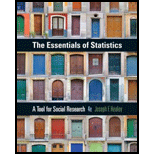
Concept explainers
For each of the following, test for the significance of the difference in sample statistics using the five- step model. (HINT: Remember to solve Formula 8.4 before attempting to solve Formula 8.2. Also, in Formula 8.4, perform the mathematical operations in the proper sequence. First square each sample standard deviation, then divide by the proper
a.
| Sample 1 | Sample 2 |
|
|
|
|
|
|
|
|
|
b.
| Sample 1 | Sample 2 |
|
|
|
|
|
|
|
|
|
(a)
To find:
The significant difference in the sample statistics for the two samples.
Answer to Problem 8.1P
Solution:
There is a significant difference between the sample statistics of two samples.
Explanation of Solution
Given:
The sample statistics is given in the table below,
| Sample 1 | Sample 2 |
The five step model for hypothesis testing:
Step 1. Making assumptions and meeting test requirements.
Step 2. Stating the null hypothesis.
Step 3. Selecting the sampling distribution and establishing the critical region.
Step 4. Computing test statistics.
Step 5. Making a decision and interpreting the results of the test.
Formula used:
The formula to calculate the sampling distribution of the differences in sample means is given by,
Where,
Where,
Calculation:
From the given information, the sample size of the first sample is 136, the sample size of the second sample is 257, the sample mean of the first sample is 72.5, the sample mean of the second sample is 76.0, the sample standard deviation of the first sample is 14.3, and the sample standard deviation of the second sample is 10.2.
As the significant difference in the sample statistics is to be determined, a two tailed test is applied.
Follow the steps for two-sample testing as,
Step 1. Making assumptions and meeting test requirements.
Model:
Consider independent random samples.
Level of measurement is interval ratio.
Sampling distribution is Normal.
Step 2. State the null hypothesis.
The statement of the null hypothesis is that there is no significant difference in the sample s of the population. Thus, the null and the alternative hypotheses are,
Step 3. Selecting the sampling distribution and establishing the critical region.
Since, the sample size is large, Z distribution can be used.
Thus, the sampling distribution is Z distribution.
The level of significance is,
Area of critical region is,
Step 4. Compute test statistics.
The population standard deviations are unknown.
The formula to calculate
Substitute 14.3 for
Simplify further,
The sampling distribution of the differences in sample means is given by,
Under the null hypotheses,
Substitute 0 for
From equation
Thus, the obtained Z value is
Step 5. Making a decision and interpreting the results of the test.
Compare the test statistic with the critical
Conclusion:
Therefore, there is a significant difference between the sample statistics of two samples.
(b)
To find:
The significant difference in the sample statistics of the two samples.
Answer to Problem 8.1P
Solution:
There is a significant difference between the sample statistics of two samples.
Explanation of Solution
Given:
The sample statistics is given in the table below,
| Sample 1 | Sample 2 |
The five step model for hypothesis testing:
Step 1. Making assumptions and meeting test requirements.
Step 2. Stating the null hypothesis.
Step 3. Selecting the sampling distribution and establishing the critical region.
Step 4. Computing test statistics.
Step 5. Making a decision and interpreting the results of the test.
Formula used:
The formula to calculate the sampling distribution of the differences in sample means is given by,
Where,
Where,
Calculation:
From the given information, the sample size of the first sample is 175, the sample size of the second sample is 200, the sample mean of the first sample is 107, the sample mean of the second sample is 103, the sample standard deviation of the first sample is 14, and the sample standard deviation of the second sample is 17.
As the significant difference in the sample statistics is to be determined, a two tailed test is applied.
Follow the steps for two-sample testing as,
Step 1. Making assumptions and meeting test requirements.
Model:
Consider independent random samples.
Level of measurement is interval ratio.
Sampling distribution is Normal.
Step 2. State the null hypothesis.
The statement of the null hypothesis is that there is no significant difference in the sample s of the population. Thus, the null and the alternative hypotheses are,
Step 3. Selecting the sampling distribution and establishing the critical region.
Since, the sample size is large, Z distribution can be used.
Thus, the sampling distribution is Z distribution.
The level of significance is,
Area of critical region is,
Step 4. Compute test statistics.
The population standard deviations are unknown.
The formula to calculate
Substitute 14 for
Simplify further,
The sampling distribution of the differences in sample means is given by,
Under the null hypotheses,
Substitute 0 for
From equation
Thus, the obtained Z value is
Step 5. Making a decision and interpreting the results of the test.
Compare the test statistic with the critical
Conclusion:
Therefore, there is a significant difference between the sample statistics of two samples.
Want to see more full solutions like this?
Chapter 8 Solutions
Essentials Of Statistics
 Glencoe Algebra 1, Student Edition, 9780079039897...AlgebraISBN:9780079039897Author:CarterPublisher:McGraw Hill
Glencoe Algebra 1, Student Edition, 9780079039897...AlgebraISBN:9780079039897Author:CarterPublisher:McGraw Hill Big Ideas Math A Bridge To Success Algebra 1: Stu...AlgebraISBN:9781680331141Author:HOUGHTON MIFFLIN HARCOURTPublisher:Houghton Mifflin Harcourt
Big Ideas Math A Bridge To Success Algebra 1: Stu...AlgebraISBN:9781680331141Author:HOUGHTON MIFFLIN HARCOURTPublisher:Houghton Mifflin Harcourt

